#python ones array
Explore tagged Tumblr posts
Note
wwx is sooo smart! in a modern setting, what subject do you think he would teach? what about in college?
seriously, i can wax poetic about wwx’s intelligence, ingenuity and smartness any day!! and ooooh, your question puts me in a bind because i cannot just name one subject. i think wei wuxian is good at too many things and the younger generations deserve to have his mentorship for an array of subjects. but i’m gonna try my best to just discuss one for this post!
see, i don’t want to mention fine arts because i think wwx would be a hobbyist about it and prefer to be one of those guys hopping around museums and galleries and curating a small but insightful review blog to engage with that side of the arts. an aspect of him that his students would probably find a bit later once they go stalking their professor’s social media profiles (which wwx would be VERY lowkey about) and find that, oh, the cool professor is so much cooler still.
also, because this got me thinking way too much, before we get to the subject, imagining wwx as a full time faculty member–i’ll go out on this fanfic fuelled limb and say he would totally be the teacher coordinator for a university play and/or the debate society! the latter especially, because if the second siege showed us nothing else, it made clear that wwx knows how to frame his arguments logically w/o getting too personal/emotional (not that some debates don’t need an emotional input!) and knows how to keep the audience hooked to his words. the same goes for the deft way in which he handled his defence at the nightless city. so, yeah.
okay, so the subject i think wwx would teach has to be....
physics!!!!!
like this is the one that pops in my mind first and foremost and it fits wwx so well and not just in the realm of engineering. not that wwx’s inventing streak won’t be profoundly useful there but when it comes teaching the subject, when i say “physics” i mean the pure science. that would be wei wuxian’s jam!! he would come up with elaborate setups to simply but elegantly explain and exhibit a complex physics law or phenomenon. he would assign practical-oriented projects to his students and allow for fun which is sorely lacking in intensive pure science classes! he would make time to go over some relevant historic trivia about some theory a guy in the 18th century came up with and he would TOTALLY gossip about the scientists of the past and the scandals so many of them were engaged in. and the most important part!! he would conceptualise different and unique experiments for his class to practice for that part of their grade! alot of the time we forget how important the practical ingenuity of physics professors need to be when it’s not applied physics because the emphasis on the theoretical classes overshadows it. but wei wuxian would plan the practical course himself, even discuss the experimental configurations with his students, and design a whole booklet with them! and ykw?? he’d teach them coding too! which is one aspect of our technological era that i think wwx would excel at because there is so much craftiness required for coding and since coding is so essential for simulations and analysis in physics, wwx could teach them...some python, lol. 😭😭 also, i want to add, wei wuxian would 100% be that college professor with a league of papers published and held in high regard so that for each course he teaches, his own work could be a relevant reference which his students would find SO cool and maybe even funny.
okay, i’m done feeding you my physics professor!wwx agenda but i also think him teaching an ethics class would be fun. and also P.E. no but imagine a sociology course with wei wuxian? or a music major? the possibilities are literally endless but you probably won’t catch wwx anywhere near a culinary school.
#ask#now why do i suddenly wanna write a modern au with profs wwx and lwj#coz professor wei wuxian would be SUCH A DELIGHT#and lan wangji is such an awesome patient fatherly teacher too#they’d be a power duo in their academia circles#wei wuxian appreciation#wei wuxian#mxtx mdzs#mdzs
44 notes
·
View notes
Text
CAFFEINE, CODE, AND COUCH CONFESSIONS



Warnings: coffee addiction
Tim Drake, the resident tech genius of Wayne Manor, had a mission: to teach you the intricacies of coding. Armed with a whiteboard, a stack of textbooks, and a steely determination, he embarked on this noble quest. Little did he know that unraveling the mysteries of Python and JavaScript would be the least challenging part.
Tim sat you down in the cozy corner of the Batcave, the glow of the Batcomputer casting shadows on his face. He explained loops, variables, and functions with the fervor of a preacher. But your brain? It was like a stubborn old laptop running Windows 95—slow, glitchy, and prone to crashing.
"Okay, so if you have a nested loop," Tim said, pointing at the whiteboard, "you'll need to—"
You interrupted. Again. "Wait, wait. What's a nested loop? Is it like a Russian doll situation?"
Tim sighed, rubbing his temples. "No, it's not—"
"But what if the Russian doll is an array?" you asked, eyes wide.
Tim's patience wavered. "It's not—"
"But what if the array contains Batman's utility belt gadgets?" you persisted.
He pinched the bridge of his nose. "That's not—"
Coding fatigue set in. Tim's eyes glazed over as you continued your relentless questioning. He needed a distraction—a break from the syntax and semicolons. So, he proposed a truce: "How about we take a snack break?"
You perked up. "Snacks? Now you're speaking my language."
Soon, the Batcave echoed with the rustling of chip bags and the clinking of coffee mugs. Tim brewed a fresh pot of coffee—the fifth one that day—and you raised an eyebrow.
"Tim, you're going to turn into a jittery metahuman," you warned.
He grinned, sipping from his mug. "Nah, I've built up a tolerance."
The couch beckoned, its cushions inviting. Tim abandoned the whiteboard, and you both sank into its plush embrace. Laptops forgotten, you fired up the gaming console. The Batcave's massive screen displayed the latest multiplayer shooter.
"Ready to kick some virtual butt?" you asked, controller in hand.
Tim hesitated. "Actually, can we watch movies instead?"
You raised an eyebrow. "Movies? Since when do you—"
"—binge-watch romantic comedies?" Tim finished, cheeks flushing. "I may or may not have a soft spot for cheesy love stories."
And so, you traded code for rom-coms, coffee for popcorn. Tim's head found its way to your lap, and you stroked his hair absentmindedly.
"Promise me," you said, "no more coffee. Your heart rate is rivaling the Bat-Signal."
He grumbled but complied. "Fine. But only because you're the best code-cracking partner."
As the credits rolled on the screen, Tim whispered, "Maybe I'll write an algorithm to predict our next movie choice."
You chuckled. "Or we could just flip a coin."
And there, in the dim glow of the Batcave, you realized that maybe—just maybe—love was the most complex code of all.
#yn#spotify#x reader#viralpost#batfam#x yn#tim drake#timothy drake#red robin#batboy#tim drake x reader#tim drake x y/n
138 notes
·
View notes
Text






Book 576
Pancha Tantra
Walton Ford
Taschen 2009
Walton Ford (b. 1960) is an American artist whose work mimics the style of naturalist illustrations, in particular those of the colonial era and often featuring extinct species. Highly symbolic and allegorical, offering clues, jokes, and references to relevant texts and other works, Ford’s paintings call out the horrors and hubris of colonialism, politics, natural history, industrialism, and humanity’s deleterious effect on the environment.
While not the first published collection of his work, Pancha Tantra is certainly the most impressive. Measuring 11.5” x 15”, 320 pages, and weighing around 8 lbs., the book offers a thrilling array of Ford’s work from the early 90s to the early aughts. While at first glance a Ford painting may appear to be a 19th century naturalist painting, there is something not quite right about it. In Diagnosis (1996), European starlings are practically being swallowed by Black-necked stork, whose namesake neck is bent back in an awkward and disturbing way. In Atma (1998), a reticulated python balances a caged lorikeet on its head. In Chingado (1998), a Brahmin bull is being suffocated by a jaguar, jaws clenched tight to the bull’s face and neck. The key to these works lies in the details: the notes scribbled in pencil along the margins, a brand on an animal’s hide, a piece of fruit from a specific part of the world is eaten by animal from another, a Latin inscription, a tiny creature being carelessly trampled underfoot by a much larger one.
Nature in Ford’s world is much more than simply “red in tooth and claw”, it is relentless and brutal, caused as much by need as by indifference and avarice, where species lost to consumption are not just cautionary tales, but premonitions.
#bookshelf#personal collection#personal library#books#library#bibliophile#book lover#illustrated book#booklr#natural history#art#pantra tantra#walton ford#taschen
16 notes
·
View notes
Text
Tierlist part 4: Python
Python is an interesting case. On one hand i absolutely hate it. The dynamic type system is not fun to work with especially when you accidentally have created a reference to an array instead of cloning it. I have never gotten round to completely understanding how class work cause it just seems like a mess. On the other hand it's a great toy. There is just a bunch of syntax like for else and the most important list comprehension that makes it an ideal playground for the writing the most cursed code. It's a good entry to code golfing because of that. So that leaves the question of where to put it. So uhmmm, let me just find the knife and do a little dissecting. There. Perfect. A tier as a toy. D tier as a language to write actual projects in.
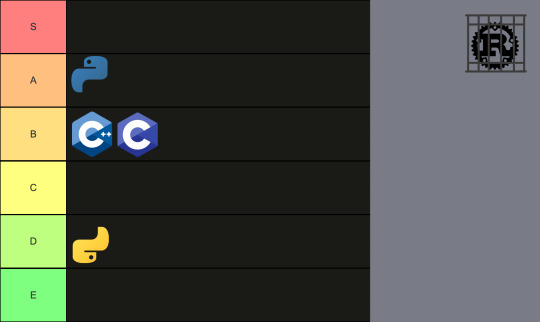
Part 3
#Possibly a bit mean towards python but i can't be kind if there is dynamic types. I am C-official after all#Seems its a good time to add conlangs to the poll#Somehow i haw voted the most popular option each time. That will probably change soon.#Im at work now and should get back to write php :(#c-official
16 notes
·
View notes
Text
All Right, Let's Do a Dumb One
LeetCode has a bunch of problems that are at this point almost famous for how laughably unrepresentative they are of work in the coding world. Like, there are points where demonstrating that you can solve one also incidentally demonstrates that you know certain kinds of critical thinking, and those questions are genuinely quite good, but most of the time it's just a Credit Score kind of thing where what you demonstrate is that you spent time practicing on LeetCode, and therefore the site made itself necessary by getting enough business decision-makers to trust it. Anyway.
This is a good example because if I got this as a question during the interview the first thing I'd do is include a disclaimer.
The challenge is to rotate an image 90 degrees. The "image" is represented by a 2D array numbered, so this happens. 123 741 456 -> 852 789 963
Now, the question says they want you to change it in-place, meaning no making a new array and slotting things in. The disclaimer I'd include is: This is a terrible idea. Making a 2D array - even a very large one, such as the kind you'd need to display something hi-def on an IMAX theater screen - is not horribly memory-intensive in the scale of memory that our computers work with today. And working in-place is terribly error-prone, both in initial creation (which someone could theoretically lay at your feet - shouldn't you be good enough to get around that?) AND in maintenance, meaning even if I know I'M hypercompetent at coding and can do it all in-place, I'm metaphorically making a bridge out of hard-to-replace materials and setting that bridge up to fall apart when the maintenance guy doesn't know how to repair it. Not doing it the way they demand you do it for the question would be part of coding best practices.
But what the hell. Let's do it. For the sake of argument.
I'd still be doing a microcosm of the same. You have to record what's in a slot without deleting it.
I'm wondering whether the intent is to run this via breadth-first search, in order to work out which spaces have already been processed? I'm going to go on that assumption.
So in a Rubik's Cube kind of way, I'm going to start from the corners. Because they're the easiest to mathematically transform to each other regardless of size, right? We're supposed to be able to do this whether the square we're rotating is 3x3 or 300x300. For a mercy, it is at least guaranteed to be a square.
We make a (starts off empty) list of processed spaces.
We make a (starts off empty) list of spaces to look at.
for x, y what happens on "rotate" exactly? In terms of corners, for an nxn grid (0, 0) gets moved to (n-1, 0) which gets moved to (n-1, n-1) which gets moved to (0, n-1) which gets moved to (0, 0). Like, in a 4x4 grid (3, 3)'s contents get moved to (0, 3). What about that second space? (1, 0) turns into (3, 1). (2, 0) turns into (3, 2). So for the top row at least, you can reverse the x and y values and invert the number of the y value, and that does it?
...I think this means you want depth-first search, actually. Because you want to be handling the square each time in order to minimize how much info you're holding at a time.
What happens is you make a nested for loop, like
for i in array: for j in list: while (i,j) not in fixed: {Block of code that adds the 4 permutations of (x,y), (-y-1,x), (-x-1,-y-1), (y,-x-1) to a list for processing and then processes them in order, finally adding i,j to fixed when it's done}
The reason this works in Python is that calling for "-1" in a list is the same as saying "length of the list -1." So on a 4x4, calling "-x-1" when x is 0 will loop around the other side of the list to find the 3.
At that point, you're only holding two points of data - the item you've just "picked up" from a given space and then the contents of the space you'll be "putting it down" in. Then you swap it out for what's in the target location.
Again, this would all be a LOT easier to just do by writing to a new list.
At that point, for each space you'd just find the space 90 degrees counterclockwise from it and set that value into the corresponding space.
15 notes
·
View notes
Text
Last month at the wiki — March 2024
Every month, we highlight significant work done in the previous month by our editing community at Encyclopedia Exandria. This one is a LONG one, so fair warning...
March 2024 saw the creation of 83 (eighty-three) new mainspace articles! A bit more on why so many later, but first here's a selection of ten of them. You can find more at the 50 newest pages report.
Zora Manning, Lightkeeper for the Circle of the Crimson Mirror
Nokari, Lightkeeper for the Circle of Tide & Bone
Isle of Serenity, island in the Glass Sea
Nymph, type of fey
Pyre, sect of the Ascendancy
Ashley Middlebrook, producer at Critical Role Productions
Ruidian glass, material found on Ruidus
Rashinna, leader member of the Volition
Gaz Tomo, member of the Volition
Vezoden Amerai, champion of the Strife Emperor
So, why so many new articles? We created individual articles for every episode of Midst! Using information we already had in list of Midst episodes, we were able to create episode articles painlessly, programmatically, and promptly with Python magic. We've also made updates to our episode infobox for Midst to document airdates for the re-releases and for subscribers, illustrators for the video versions, and appendices links. Now that we've got individual articles, the summaries on the list were made more concise to provide different levels of summarization and to make appendices links easier to see. Work is also underway on the individual articles, including more robust summaries (now that they're standalone rather than in a table), appendices summaries, and illustration galleries. You can check out the articles for Unrise, Switcheroo, and Tempest for a peek at what we're aiming for and slowly moving toward.
Character infoboxes now have a place for movement speeds, making it easier to do thought experiments about which PC will win in a race. Also, we've historically had explanatory notes for multiple stats or DCs in a hover. We've changed our best practices to instead place these into a footnote formatted similar to references so that these notes can be accessed by mobile users.
The character infobox was also updated to handle stats for systems other than Dungeons & Dragons. We've added new items for Daggerheart (we're still getting a feel for what should be included), and we have options for a full custom stat array. This allows us to better handle Daggerheart characters in the future, should we see more of them, but also to better handle PCs in past one-shots who were not well-serviced by the less flexible stat handling. We've also inserted new fields to properly reflect Daggerheart's Community and Ancestry character options.
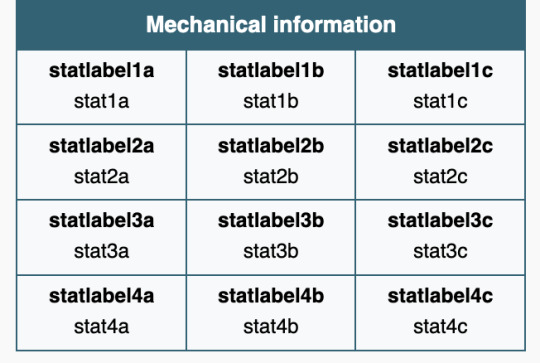


As always, check out our Candela Obscura coverage. Newfaire has been updated with more points of interest from the core rulebook. We've also got a lengthy bibliography of interviews related to the show on top of our regular coverage for this month's continuing adventures of the Circle of the Crimson Mirror.
35 notes
·
View notes
Text
Python Libraries to Learn Before Tackling Data Analysis
To tackle data analysis effectively in Python, it's crucial to become familiar with several libraries that streamline the process of data manipulation, exploration, and visualization. Here's a breakdown of the essential libraries:
1. NumPy
- Purpose: Numerical computing.
- Why Learn It: NumPy provides support for large multi-dimensional arrays and matrices, along with a collection of mathematical functions to operate on these arrays efficiently.
- Key Features:
- Fast array processing.
- Mathematical operations on arrays (e.g., sum, mean, standard deviation).
- Linear algebra operations.
2. Pandas
- Purpose: Data manipulation and analysis.
- Why Learn It: Pandas offers data structures like DataFrames, making it easier to handle and analyze structured data.
- Key Features:
- Reading/writing data from CSV, Excel, SQL databases, and more.
- Handling missing data.
- Powerful group-by operations.
- Data filtering and transformation.
3. Matplotlib
- Purpose: Data visualization.
- Why Learn It: Matplotlib is one of the most widely used plotting libraries in Python, allowing for a wide range of static, animated, and interactive plots.
- Key Features:
- Line plots, bar charts, histograms, scatter plots.
- Customizable charts (labels, colors, legends).
- Integration with Pandas for quick plotting.
4. Seaborn
- Purpose: Statistical data visualization.
- Why Learn It: Built on top of Matplotlib, Seaborn simplifies the creation of attractive and informative statistical graphics.
- Key Features:
- High-level interface for drawing attractive statistical graphics.
- Easier to use for complex visualizations like heatmaps, pair plots, etc.
- Visualizations based on categorical data.
5. SciPy
- Purpose: Scientific and technical computing.
- Why Learn It: SciPy builds on NumPy and provides additional functionality for complex mathematical operations and scientific computing.
- Key Features:
- Optimized algorithms for numerical integration, optimization, and more.
- Statistics, signal processing, and linear algebra modules.
6. Scikit-learn
- Purpose: Machine learning and statistical modeling.
- Why Learn It: Scikit-learn provides simple and efficient tools for data mining, analysis, and machine learning.
- Key Features:
- Classification, regression, and clustering algorithms.
- Dimensionality reduction, model selection, and preprocessing utilities.
7. Statsmodels
- Purpose: Statistical analysis.
- Why Learn It: Statsmodels allows users to explore data, estimate statistical models, and perform tests.
- Key Features:
- Linear regression, logistic regression, time series analysis.
- Statistical tests and models for descriptive statistics.
8. Plotly
- Purpose: Interactive data visualization.
- Why Learn It: Plotly allows for the creation of interactive and web-based visualizations, making it ideal for dashboards and presentations.
- Key Features:
- Interactive plots like scatter, line, bar, and 3D plots.
- Easy integration with web frameworks.
- Dashboards and web applications with Dash.
9. TensorFlow/PyTorch (Optional)
- Purpose: Machine learning and deep learning.
- Why Learn It: If your data analysis involves machine learning, these libraries will help in building, training, and deploying deep learning models.
- Key Features:
- Tensor processing and automatic differentiation.
- Building neural networks.
10. Dask (Optional)
- Purpose: Parallel computing for data analysis.
- Why Learn It: Dask enables scalable data manipulation by parallelizing Pandas operations, making it ideal for big datasets.
- Key Features:
- Works with NumPy, Pandas, and Scikit-learn.
- Handles large data and parallel computations easily.
Focusing on NumPy, Pandas, Matplotlib, and Seaborn will set a strong foundation for basic data analysis.
8 notes
·
View notes
Text
october 2nd 2024: some code stuff
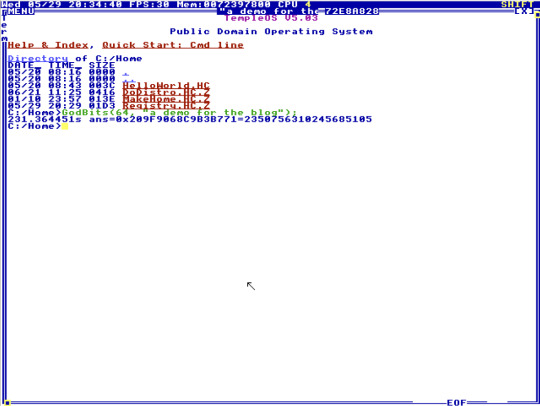
preacher: the original idea behind "APRIL" was that she would be able to pull up word strings from the templeOS god word app on command – this was supposed to be her primary/only function.
we're going to put up a post on templeOS later because it's completely fascinating and i've been obsessed with it for a while, but for now what's important to know is that due to some decompiler issues, it's not really possible to run templeOS on the raspberry pi which is the computer that we are using. scott's here to explain this at length – find a detailed technical explanation below the cut.

scott: Initially I was gonna start coding the whole program in Python starting with the godword random prophecy function. But then after looking into how the original godword program worked on the og TempleOS worked, with FIFO (First-in-First-out) queues, of which I was pretty unfamiliar with, I decided to code the bulk in C because I know C a lot more than Python and the queues seemed easier to implement in C. Pi allows both Python and C coding languages naturally anyways so why not.
The original TempleOS was written in a variation of the C/C++ language called HolyC by Terry A. Davis who wrote the language variant and compiler himself. Because of this, it's hard to decompile it manually to look at source code, or to run it on certain machines. Because of this I couldn't run the actual godword program or TempleOS on the raspberry pi so I knew I was gonna have to recreate the godword function as close as I could (which I initially called "heresyword" lol). After some research, I found one of the only breakdowns of how TempleOS worked by Xe Iaso [1].* They have such a good breakdown of the whole operating system thats really context inclusive and even includes extracts from Terry Davis' actual comments on how TempleOS works which are really hard to interpret actually. * (preacher: btw, i highly recommend everyone read this link. it really does a great job of explaining everything and once again, templeOS is endlessly fascinating so i think it's really worth the read. see the picture below for an example)

So from Xe's blog I found that TempleOS has a public global class called "God" that is used in several areas of the operating system. For godword it loads all words from the database Happy.txt into a separate array and then uses random entropy bits from several areas, including an "internal microsecond stopwatch" and data form keypresses, to choose random words from the word variable and loads them into a FIFO queue, printing them one by one when needed. I was initially gonna recreate this FIFO queue and all these random entropy bits but decided it to be too much complicated work for little result so just decided to generate random words from the Happy.txt using the cpu clock for entropy and save them to a separate .txt file to be called and read later on, acting in place of the queue system.
Sidenote: Xe's blog also had the Happy.txt file which was really useful and which I also realised was just every single word from the King James Bible.
#scott#preacher#coding#templeos#terry davis#software engineering#programming#code#holy c#computers#computer#tech#technology#machine#machines#techcore#webcore#old web#retro tech#divine machinery#divine technology#raspberry pi#update
7 notes
·
View notes
Text
I've taken 3 college level intro cs classes in the last 8 years and not completed a one of them. they've also all been for different languages (java, c++, & python). I am now about to embark on my FOURTH intro cs class which just says it's for an unspecified high-level coding language. which probably means python, I'd think.
anyways. all this to say I'm Really Good at leveraging if/for/while & basic array manipulation to do whatever I want but have absolutely no grasp on real programming. perhaps I'll finally remedy that?
#txt#the javascript hardcode in proverbs is all either#a) copypasted and blended until it does what i want#or b) using a hammer and chisel to do in fifty lines what an electric drill could do in two
8 notes
·
View notes
Text
Mastering Data Structures: A Comprehensive Course for Beginners
Data structures are one of the foundational concepts in computer science and software development. Mastering data structures is essential for anyone looking to pursue a career in programming, software engineering, or computer science. This article will explore the importance of a Data Structure Course, what it covers, and how it can help you excel in coding challenges and interviews.
1. What Is a Data Structure Course?
A Data Structure Course teaches students about the various ways data can be organized, stored, and manipulated efficiently. These structures are crucial for solving complex problems and optimizing the performance of applications. The course generally covers theoretical concepts along with practical applications using programming languages like C++, Java, or Python.
By the end of the course, students will gain proficiency in selecting the right data structure for different problem types, improving their problem-solving abilities.
2. Why Take a Data Structure Course?
Learning data structures is vital for both beginners and experienced developers. Here are some key reasons to enroll in a Data Structure Course:
a) Essential for Coding Interviews
Companies like Google, Amazon, and Facebook focus heavily on data structures in their coding interviews. A solid understanding of data structures is essential to pass these interviews successfully. Employers assess your problem-solving skills, and your knowledge of data structures can set you apart from other candidates.
b) Improves Problem-Solving Skills
With the right data structure knowledge, you can solve real-world problems more efficiently. A well-designed data structure leads to faster algorithms, which is critical when handling large datasets or working on performance-sensitive applications.
c) Boosts Programming Competency
A good grasp of data structures makes coding more intuitive. Whether you are developing an app, building a website, or working on software tools, understanding how to work with different data structures will help you write clean and efficient code.
3. Key Topics Covered in a Data Structure Course
A Data Structure Course typically spans a range of topics designed to teach students how to use and implement different structures. Below are some key topics you will encounter:
a) Arrays and Linked Lists
Arrays are one of the most basic data structures. A Data Structure Course will teach you how to use arrays for storing and accessing data in contiguous memory locations. Linked lists, on the other hand, involve nodes that hold data and pointers to the next node. Students will learn the differences, advantages, and disadvantages of both structures.
b) Stacks and Queues
Stacks and queues are fundamental data structures used to store and retrieve data in a specific order. A Data Structure Course will cover the LIFO (Last In, First Out) principle for stacks and FIFO (First In, First Out) for queues, explaining their use in various algorithms and applications like web browsers and task scheduling.
c) Trees and Graphs
Trees and graphs are hierarchical structures used in organizing data. A Data Structure Course teaches how trees, such as binary trees, binary search trees (BST), and AVL trees, are used in organizing hierarchical data. Graphs are important for representing relationships between entities, such as in social networks, and are used in algorithms like Dijkstra's and BFS/DFS.
d) Hashing
Hashing is a technique used to convert a given key into an index in an array. A Data Structure Course will cover hash tables, hash maps, and collision resolution techniques, which are crucial for fast data retrieval and manipulation.
e) Sorting and Searching Algorithms
Sorting and searching are essential operations for working with data. A Data Structure Course provides a detailed study of algorithms like quicksort, merge sort, and binary search. Understanding these algorithms and how they interact with data structures can help you optimize solutions to various problems.
4. Practical Benefits of Enrolling in a Data Structure Course
a) Hands-on Experience
A Data Structure Course typically includes plenty of coding exercises, allowing students to implement data structures and algorithms from scratch. This hands-on experience is invaluable when applying concepts to real-world problems.
b) Critical Thinking and Efficiency
Data structures are all about optimizing efficiency. By learning the most effective ways to store and manipulate data, students improve their critical thinking skills, which are essential in programming. Selecting the right data structure for a problem can drastically reduce time and space complexity.
c) Better Understanding of Memory Management
Understanding how data is stored and accessed in memory is crucial for writing efficient code. A Data Structure Course will help you gain insights into memory management, pointers, and references, which are important concepts, especially in languages like C and C++.
5. Best Programming Languages for Data Structure Courses
While many programming languages can be used to teach data structures, some are particularly well-suited due to their memory management capabilities and ease of implementation. Some popular programming languages used in Data Structure Courses include:
C++: Offers low-level memory management and is perfect for teaching data structures.
Java: Widely used for teaching object-oriented principles and offers a rich set of libraries for implementing data structures.
Python: Known for its simplicity and ease of use, Python is great for beginners, though it may not offer the same level of control over memory as C++.
6. How to Choose the Right Data Structure Course?
Selecting the right Data Structure Course depends on several factors such as your learning goals, background, and preferred learning style. Consider the following when choosing:
a) Course Content and Curriculum
Make sure the course covers the topics you are interested in and aligns with your learning objectives. A comprehensive Data Structure Course should provide a balance between theory and practical coding exercises.
b) Instructor Expertise
Look for courses taught by experienced instructors who have a solid background in computer science and software development.
c) Course Reviews and Ratings
Reviews and ratings from other students can provide valuable insights into the course’s quality and how well it prepares you for real-world applications.
7. Conclusion: Unlock Your Coding Potential with a Data Structure Course
In conclusion, a Data Structure Course is an essential investment for anyone serious about pursuing a career in software development or computer science. It equips you with the tools and skills to optimize your code, solve problems more efficiently, and excel in technical interviews. Whether you're a beginner or looking to strengthen your existing knowledge, a well-structured course can help you unlock your full coding potential.
By mastering data structures, you are not only preparing for interviews but also becoming a better programmer who can tackle complex challenges with ease.
3 notes
·
View notes
Text
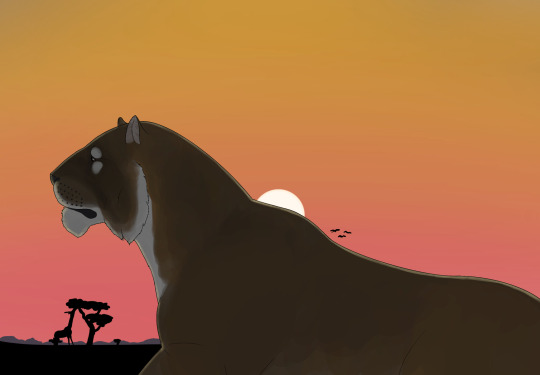
The sun is rising on the savannah. An old cat is resting amidst the grassland. He looks at the territory he held for almost six years at this point, much longer than almost any other male of his species. He’s a Machel’s lion (Leorex macheli), the apex predator of Aethiopia.
This new continent split from mainland Africa just before the interchange and was thus unaffected by it, with many lineages declining or extinct in Afrolaurasia still thriving here, east of the Great Rift Valley and the African Great Lakes.
Moving eastwards and exposed to the currents of the newly formed sea this continent’s climate is slowly but steadily changing. With the Asian monsoons now finally reaching the Eastern coast the first coastal forests are popping up on the edges of the Horn of Africa’s desert, and thanks to the rains brought from the West and strengthened by the equatorial currents the Lake Victoria rainforest was able to expand.

This rainforest is one of the most biodiverse areas of Earth, being so small in size but still hosting so many species. It’s inhabited by a wide array of wildlife. The largest are the ground dwelling primates, the pomorangs (Kampalapithecus chimpiskii), and the many forests antelopes of the genus Relictotragus, or kasolyas.; reptiles and birds alike inhabit the forest, with the most notable ones being pythons, water monitors, parrots and the junglefowl introduced in the Holocene; and a lineage extinct in the rest of the world is still found here, the Smutsiinae, with the still thriving East African giant pangolin (Catiosmutsia aethiopica).
The savannah doesn’t differ much from that of the Anectyocene, with cats, antelopes, dogs, perdvarks and gouebeervarks still being the most common sight there. The main difference here is the evolution of the tomeutheriid, and thus hyracoid, Zoshkoko (Tomeutherium ingens), the largest land animal of the continent, reaching 4 metres in height and rivaling the Pleistocene straight tusked elephant at around 14 tons in weight.
In the last million years there has also been a remarkable case of convergent evolution, with a population of laangvos adapting to a more frugivorous diet and establishing a symbiotic relationship with the Kei apple, eventually evolving into the shaggy wolf (Phytocyon keiophilus), uncannily similar to the maned wolves of South America.

#spec evo#spec bio#speculative evolution#speculative biology#worldbuilding#artwork#digital art#epigene period#future earth#future evolution
10 notes
·
View notes
Text
hey, isn’t that ATTICUS COHEN-LEVY, who looks a little like DEAKEN BLUMAN? i hear HE is a 27 year old CIS MALE who works as a LIBRARIAN @ TURNING LEAVES who has been in town for HIS ENTIRE LIFE. they ARE a member of one of aspen creek’s founding families. you can usually find them at SUNNYVALE COMMONS or SUZIE’S ANTIQUE. if you ask me, they remind me a lot of THE SMELL OF OLD LEATHER BOOKS, A WARM CUP OF COFFEE LATE AT NIGHT, MELANCHOLY THAT LINGERS, A LOVE FOR THE WEIRD AND THE OCCULT. just keep an eye on them & see if their true colors shine through!

tw for depression.
FULL NAME: atticus xavier cohen-levy
NICKNAMES: ace, atty
PARENTS: tba.
SIBLINGS: everly cohen-levy ( older sister ), daphne cohen-levy ( younger sister ).
PETS: yellow ball python named bartholomew ( bart for short ), black stray cat named lilith
THE BIG THREE: capricorn sun, sagittarius moon, aquarius rising
SEXUAL ORIENTATION: demisexual, panromantic
OCCUPATION: librarian at turning leaves, writer
LANGUAGES: english ( native ); french and german ( fluent ); spanish, russian and ASL ( studying )
Atticus has always been an awfully quiet and reserved child, had the hardest time making friendships or keeping them and preferred the company of books than most people. The only people he’d open up to were the array of siblings he’d been lucky enough to have grown up with, being the second oldest child of the family, but he mostly stayed locked inside his own brain, whether that’d be to torture himself or create something beautiful. Atty wasn’t a very social person but he found other ways to fill up that void, burying himself into studies of philosophy and literature. Whilst his siblings were out and about, he was back at home, studying and reading and absorbing all the knowledge he could. He also became fluent in French and German out of pure boredom.
His love for the occult and the unknown started as soon as he found said section tucked inside the library, the stories and myths creating a new sort of curiosity inside of a young Atticus and he became fascinated. Quickly, he became a true believer in all things that were considered “weird” or “paranormal” as they mesmerized him and is also an avid conspiracy theorist to this day. He’d often find himself in trouble in his teenage years while trying to find evidence of the things he’d read about but was never disappointed when he couldn’t find anything — as a matter of fact, that only fueled his curiosity even more.
Despite not needing or even wanting to create deep connections with others, Ace still was hugged by a deep sense of loneliness and sadness from time to time. Later on in life when he finally decided to seek for explanations, he’d find that he had clinical depression. It’s almost like his brain couldn’t properly process the good emotions, leaving him only with that sense of emptiness that followed him everywhere he went.
Atticus then took all of that loneliness, all of that pain, and sadness and turned it into something good. He found his solace in the arts, he started to draw, write and even compose. He had begged his mother for a cello and after years of insistence, he was finally gifted one. That only made him even more reclusive, rare were the days that Atticus’ skin would see the sun.
In his adolescence, he was also faced with his questions of sexuality and the fact he was actually demisexual. He liked to be alone but the idea of having someone romantically by his side awoke something in him that he hadn’t thought of before — he wouldn’t mind having a person of any gender by his side but he just didn’t want them like normal people did. It was all too confusing for him as he had grown up with the thought that he was broken because he wasn’t like that. Until he became truly enamored by someone in high school, someone who served as a muse for him for the whole time they were together, and even in later years, and that was the first and only person he’s ever been with. Their relationship lasted for a few years until they eventually decided to part ways in their twenties. Atticus would be lying if he said he still doesn’t think about them.
His adult years were as confusing as his teenage years but Atticus had become more aware of the person he was, accepting himself as the weirdo he inevitably became. Keeping his love for the arts, continuing to compose and write poetry, studying new languages and learning new instruments. He’s still working on his drawings, his website is filled with artworks up for sale, and has finally started to work on a novel of his own. Currently, he works as a librarian at the Turning Leaves after earning his bachelor’s degree in English. He’s the sole occupant of his small, cozy home in Sunnyvale Commons but has two pets to keep him company when he’s up until four in the morning working on a new piece. He can also be easily found at the The Cozy Nook; drinking unhealthy amounts of coffee while working, at Suzie’s Antiques; collecting vintage items, or at the woods somewhere; in the evenings, trying to connect with the nature and the supernatural beings that might live in the area.
2 notes
·
View notes
Note
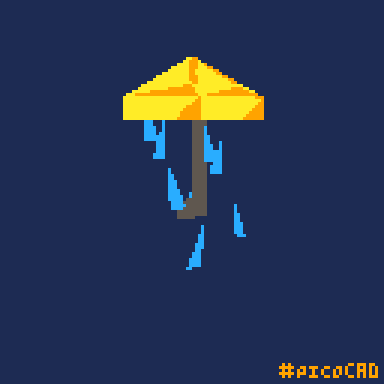

HAPPY BIRTHDAY TO YOU 💥💥💥 (ON TIME THIS TIME)
for the q&a: what projects are you currently working on? what projects would you *like* to do in the future?
THANK YOU (ONE DAY LATER)
I ve just started my second semester so obviously its time for me to start working on a wide array of projects lmao
i still have the color deconstructor and the pixelart choose-your-adventure game on the backburner. my teacher gave me some advice for the first one and i was gonna do it during hollidays but then i realized it'd be the 4th time i do it and i almost lost all my motivation. im thinking about doing both of them as part of my neocity site but i need to learn openGL/webGL so that's dependent on me finding a good book for that
ideas for drawings are few and far between and the motivation to do them is even lower. i've actually thinking about doing an extra comic for my terumob comic series
once in a while i do some coding but the results aren't flashy enough for me to talk about it here. lots of color manipulation and stuff using images like this code that limits the colors of an image based on the colors of the second image (i know it looks ugly, i coded it just now)

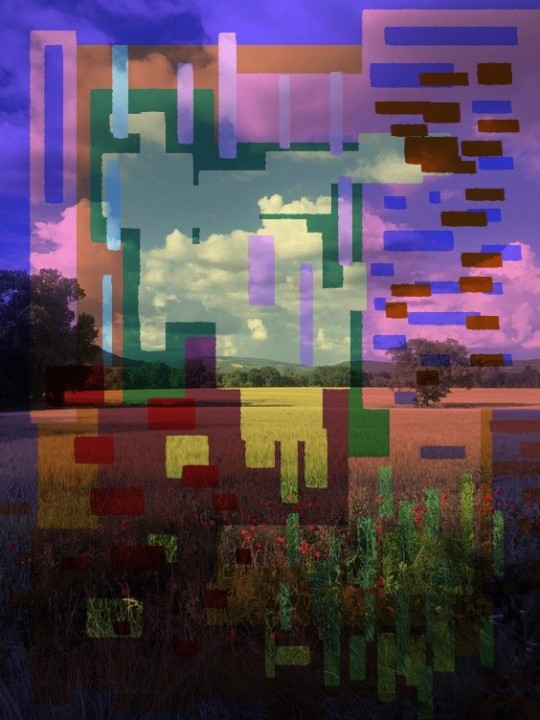
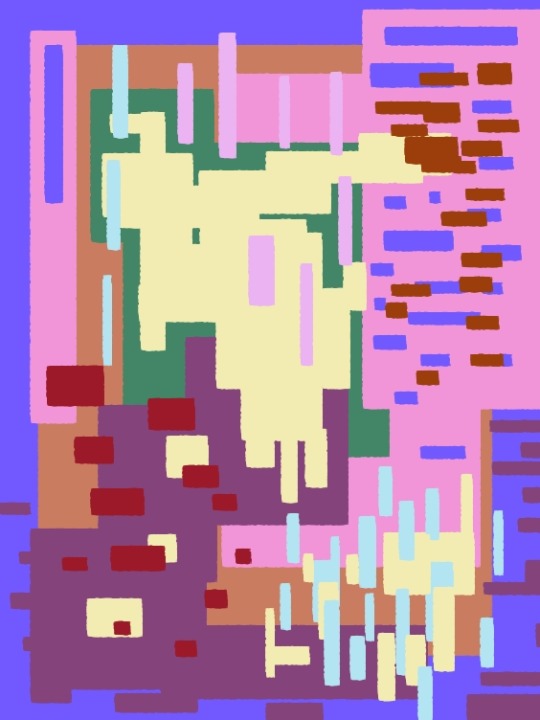
something i've been thinking about is the way dwarf fortress deals with animals and other creatures. you have RAW files made out of tokens, like these from the unicorn (incomplete):
[CREATURE:UNICORN] [DESCRIPTION:A horse-like creature with a spiral horn growing from its forehead.] [NAME:unicorn:unicorns:unicorn] [CASTE_NAME:unicorn:unicorns:unicorn] [CREATURE_TILE:'U'][COLOR:7:0:1] [CREATURE_CLASS:MAMMAL] [PETVALUE:1000] [PREFSTRING:horns] [VISION_ARC:50:310] [GOOD] [LARGE_ROAMING] [POPULATION_NUMBER:15:30] [CLUSTER_NUMBER:3:7] [GRASSTRAMPLE:0] [NO_VEGETATION_PERTURB] [STANDARD_GRAZER] [BIOME:FOREST_TAIGA] [BIOME:ANY_TEMPERATE_FOREST] [BIOME:ANY_TROPICAL_FOREST] [BIOME:SHRUBLAND_TEMPERATE] [BIOME:SHRUBLAND_TROPICAL] [BENIGN][MEANDERER] [BODY:QUADRUPED_NECK_HOOF:TAIL:2EYES:2EARS:NOSE:2LUNGS:HEART:GUTS:ORGANS:THROAT:NECK:SPINE:BRAIN:SKULL:MOUTH:TONGUE:GENERIC_TEETH:RIBCAGE:HEAD_HORN:EYELIDS:CHEEKS] [PET][MOUNT][PACK_ANIMAL]
the game looks at these and creates a creature with those characteristics. this is also the reasin dwarf fortress has like 200 animals. everything in the game is based on raws but im mostly focused on the animal part of it. i've been thinking about trying to recreate this system just for the fun of it (no idea what i'd use it for lol) i have some ideas but i'd like to do some more research
im also thinking about doing this on python bc i really wanna learn python
9 notes
·
View notes
Text
Caught a subtle bug today.
Loading a bunch of parallel number arrays into python from a JSON response then front-padding the short ones with NaN.
numpy.pad raises a ValueError if one of those short arrays happens to contain only integer values.
Solved by passing parse_int=float to the json.loads call.
3 notes
·
View notes
Text

Decided to challenge myself by drawing every single TLK character out there, up until this point in time, and post it here. You can see the finished project on my main account, though I figured to post it on my tumblr just show I could proudly show off my work and a few of my head canons.
Here's all the 'bugs'(i.e. spiders, mollusks, insects, etc) across TLG/K:
Starting off with the arachnids and the spiders, starting off with the most widespread real-life and apparently in-universe figure as well, Anansi. Anansi the spider serves a similar story to the ones we have in real-life for the animals in the world of TLK/G, so if you want to learn more about him, please reference any story out there, though the ones with humans are probably replaced with other animals or removed entirely in this universe. Anansi is a trickster spider who can either be friend or foe, depending on what story. Sometimes he is a beneficial character, such as earning the world's stories/knowledge and spreading it to the world, other times he is a slothful, thieving trickster. Whatever the story, he mostly certainly is a well-known character in this world, and even seen as a figure for more 'thieving' animals like jackals and scavengers, offering prayers in his name to help them be more clever and sneaky. Because of this deific status. I took the same approach as my take on the Werehog and Mooks, making it more artistic and elaborate, not so much as drawing a character, more like a story idea. I took inspiration from this AI-art of Anansi, which I feel is what AI art should be used for, not as a replacement, but as a tool, something to aid, but not replace your own talents/skill. I had considered also doing his wife and son, but this sheet was already kinda difficult to figure out what to do, so I skipped it, plus he apparently has multiple children across the stories.
I also depicted a few scenes from his stories around him, namely, the story of how he got the right to all the world's stories by depicting each of the trials in order to prove himself worthy; catching the hornets in the gourd, capturing both the python and leopard, and trapping the fairy with the yams and the gum doll, which I figured a butterfly for the fairy would work just as well here. I might've taken a few ideas from Tinga Tinga tales animal designs here.
Next spider is Makuru Kasiksi('Great'-Shona + 'Prosecutor'-Sudanese), from Operations Pridelands and is one of the animals Timon and Pumbaa must bring back. She is a spider sleeping in her web and the player must use fireflies to light Timon and Pumbaa's path as they steal her food in order to force her back into the Pridelands. In truth, Simba was hoping to get back as many animals as he could in order to replenish the ecosystem, so spiders, if possible, were asked to be brought back along. Makuru is a golden orb weaver spider, which, surprisingly, do have white/black markings that can resemble faces or skulls, so purple coloring aside her original design is rather solid, though I did give her eight eyes to fit her species.
Last of the spiders come from the duo we see in TLK 1 1/2; Kusuka(weave) and Mtandao(web), and 'Anansi'-'spider' from "The Cave Monster". The happy couple are a pair of Napoleon spiders, mostly because due to looking for 'colorful African spiders' was pretty hard to get through and I really couldn't find any blue/pink striped ones. Napoleon spiders seem to come in a multiple array of colors, from red through yellow and white, however if TLK can have blue hornbills and red lions, I figured it be alright if we have a blue Napoleon spider. As for the latter, some say that giving the name Anansi or other gods' names, or naming one after their own species, to animals allow them to inhabit you or share their divine aspects with you(i.e. a lion named Simba or a elephant name Tembo, etc.). Regardless, this "Anansi" is just a common tiny African bark spider, cleverly using some light tricks and echoes to make himself look more intimidating and bogger to keep away predators.
Finishing up with the arachnids, we got our only scorpion: Sumu(poison) the Tanzanian red clawed scorpion. A very mildly venomous scorpion species, so here's my pitch for Sumu. I really like the story, a race against the clock to get the medicine for Simba as his life hangs in the balance from the venom. However, I think they could've gone more with it. Sumu's real-life species, whole should be handled with care, are nowhere near the levels of lethality for taking out an adult male lion. So there's three ways I could fix this: first being is that Sumu's venom isn't actually that dangerous, and Sumu knows this, so he dips his stinger with herbs and pother things that would increase the potency of his stinger, sort of like Scorpion from Kung Fu Panda Legends of Awesomeness. The second option is to just turn him into a more lethal scorpion species, like fat-tailed or even a deathstalker scorpion. Though then we'd lose the edgy, dark coloring. The third option, and the one I prefer, is just losing the scorpion overall and swapping him with a black mamba. Quick, notorious, lethal, it do just a good of job if not better then a scorpion, and I even have an entire picture detailing my argument as well as how implementing it would even be better for the overall storyline. But I digress, plus this is a 'bugs'-only picture, so here's Sumu in all his scorpion glory. Nothing much different, though I did notice he had only four eyes while scorpions have between six and twelve, so I just added two extra, plus actually give him the red claws, and turned those gross, inaccurate head hairs into markings. Also referenced my black mamba picture of him with the shadow in the background.
I was surprised that we had a dung beetle character introduced in the Pride Lands Pedia; Dembe(sack), voiced none other then Ono's voice actor Atticus Shaffer. Good for him. Anyways, I kinda feel like this character would be a sort of a meta-narrator for bug stories, as in every story told by other creatures about bugs has a sort of inner-story narrator and its him.
Next up we are heading into more obscure territory. Most of these are from the Timon and Pumbaa Show or TLG, though I'm going to mostly just list them out and move on.
Starting off with the bees we have Buzz/Nyuki(bee) and Queen bee/Inyosi(bee-Zulu) from "To Be Bee or Not To Be Bee". Next is Tok the toktokkie beetle from Rafiki Remembers: "Toktokkie the Beetle". They're a kind of beetle known for unique clicking noise they make, caused by them raising and lowering their abdomen onto surfaces, like knocking, in quick sequences. Additionally, they also do 'headstands' in the early morning/late evening when the fog roles in, allowing them to collect condensation which then rolls down to their mouths. I chosed the striped variant for this sheet,
Continuing on with the Timon and Pumbaa Show bugs we have Stinky/Uvundo(stinky) the black stinkbug from "Rocky Mountain Lie", and Big Bad Bug/Baya(bad) from "One Tough Bug", who is a Giant African Fruit Beetle, a massive and beautiful bug that feeds on rotting wood and fruits. Also some of the largest beetles in the world. Not exactly what I would call bad, unless you're a fruit farmer, in which case probably would be bad. Next is Bookworm/Ikpuru(worms) from "Library Brouhaha". He's a caterpillar here, since, you know, no books in TLK, plus there was a green caterpillar in TLG that kinda looked like him. Honestly the original character feels like he belongs in SpongeBob.
Next we have the termites; Woody Woodeater III/Idiya(eat-Nyanja) from "Going Uruguay" and Kisangani("City on the Island") the termite queen, who imprisoned Gozi the frog in a termite hill. Because these creatures don't have sapience, the two are mostly names given to them by the characters, mostly as brief descriptors. Woody Woodeater III was probably a termite Timon named as part of an example to Simba of what insects were good to eat, while Kisangani, the last of our Operation Pridelands characters, was the name Ngozi/Gozi the frog gave to the termite mound that had mistakenly entrapped her during her hibernation period by building their mound over and around her, forcing Timon and Pumbaa to figure out how to break her out. In my verse, Idiya and Kisangani are part of the same mound, though since there's apparently is such a thing as a king termite, Idiya has a very important role as Kisangani's partner in keeping the populations up.
Next up we have the more general creatures, aka insect species which didn't get a name/character per say, but are mentioned in the show/movie/etc, though I just love making extra work for myself, so here's the animal and a brief fact about them.
Cockroaches: Apparently cockroach can live up to a week without its head and can live up to three months without food and a month without water. All the more reason to believe that if we do end up with a nuclear apocalypse, these guys will most likely survive.
Ladybugs: evidently they can also come in pink like this Lipstick Lady Beetle from South Africa, as well as yellow, orange, black, and white, spotted, striped, blotched, plain or even smiley faced.
Scarab beetles: Apparently the reason why many of them are so shiny is because these beetles manipulate the reflection of light to make themselves appear daringly flashy to certain eyes and completely camouflaged to others. Also there are some that look completely golden.
Grasshoppers: Went with an elegant grasshopper, since not only are they lovely, but apparently their bright colors have deter predators for so long they almost completely lost their wings and are entirely unable to fly, though some still do due to recessive genes. Also these things are massive, like really big.
Crickets: Almost went with an armored cricket, since those things are massive and cool, though apparently they aren't true crickets and are actually more related to katydids, so went with your standard brown cricket. Also tiny next to their grasshopper cousins... yeah he's gonna get eaten by that guy. Worms: Don't show up in the show, but in the first film and The Lion Guard Magazine. These guys are able to absorb air right out of the air into their skin and directly into their bloodstream. Also the world's largest segmented worm can be found in Africa, ranging from 4.5 ft to 22 ft long.
Ants: Used an African army ant/driver ant here, which do actually play a big role in the story "How True, Zazu?" in where a giant swarm of them descends on the Pridelands, only to be stopped when the Pridelanders dam up the river and flood them away. Apparently some indigenous African tribes will actually use army ants as makeshift sutures, having them bit down on gnashes and then breaking off the body, leaving the jaws in as stiches. Also while looking up the army ants on my personal copy of 6NAs, I discovered apparently TLK wasn't the only Disney property to get them, as Pocahontas, Aladdin and Hunchback of Notre Dame received them as well. Neat.
Butterflies: Went with a giant blue swallowtail, a beautiful butterfly species of the family Papilionidae, named in the honor of Zalmoxis, a divinity of the Getae people of the lower Danube, the second biggest river in Europe.
Dragonflies: Went with a scarlet darter, since it was a striking red. Also found out that with the publication of the new discoveries in recent years, the number of dragonfly species known in Africa has increased from 700 to 760 species.
Fireflies: You probably know these guys, though do you know how they make their light is that they have special organs under their abdomens that take in oxygen, and inside special cells, they combine the oxygen with a substance called luciferin to make light with almost no heat? Also apparently their eggs glow too. Underneath we have Madame Credenza/Mkadam(ahead) the African moon moth from "Beetle Romania", a truly beautiful moth.
Tsetse flies: Tsetse flies are the scourge of Central Africa, known for their painful bites that can transmit African trypanosomiasis or 'sleeping sickness'. With the fleas, I figured to group the pests together. I found out whole researching fleas that apparently fossil records in China show they've been around for at least 165 million years ago, meaning dinosaurs could've had fleas. Shingo might not be as ancient or big as those animals, though he still probably hates them just as much. Getting double trouble here.
Finishing off with the last two groups, first we have three tasty grubs for Timon, Pumbaa, Bunga, and any insectivore really; Gourmetus Salavati from "Paraguay Parable", now interpreted be a type of beetle, TLG's Utamu, a type of moth/butterfly caterpillar I assume, as well as the one grub we see in the first film, you know the one.
And last, but certainly not least, the mollusks; Slippy/Shimizi(slip) the giant African land snail from "The Missing Monkey" and Speedy/Spidi(speed) the now giant tiger land snail from the Timon and Pumbaa Show. Giant African land snail, the largest of all land snails and native to East Africa, though unfortunately an invasive species in most of the world. I remember going to Hawaii a few years back, seeing a big shell on a grassy spot, went to go pick it up, whoops, its a large freaking snail. The giant tiger land snail is around the same size and same distribution as the other, though doesn't seem to be as much as an invasive species. To be honest I pretty much blended Speedy's regular and Super Duper Hero X's appearances together.
6 notes
·
View notes
Text
O2A2 Daily Log. DAY/NiGHT 1 (July 5th, 2024)
I'll be posting these until I get to the game's development conclusion!
Day I.
It was around 10 AM when I started working. My initial process laid in drafting the story. After deciding on the main character (in this case, Amaranth) I stripped the story to its two components – place and premise – because in other cases it’d be down to building the plot off of a character, and my mind runs wild whenever I construct it like that.
The place is the library, where souls come after they’ve passed, so an Afterlife Library. And the premise is quite simple – it’s a game for the player’s life! In this case, instead of a gamble it all comes down to outsmarting the machine, ahem, the experienced librarian.
And as a person who barely knows Python beyond freely coding in Ren’py, I wandered to the search engine to find a tutorial and realised that I’ll probably be better off searching on Reddit. One of the posts gave me a really good idea – the OP was talking about imagebuttons and logic and then it clicked for me.
Tic-tac-toe is a game where you draw the image inside the grid spaces, taking turns and adjusting your movements to your opponents’... Was it possible to code something like that?!
(duh, of course it was, this log is a testament to that)
I started by cropping the supposed “images” (solid blocks of two colours – one for the scroll and one for the charcoal), and cropped tiny squares of the scroll's colour. So the layering was like this – background scroll - big dark square - vertical box full of horizontal boxes of scroll’s colour, creating the illusion of a drawn grid, when in reality it is not.

And this marks the beginning of my two-hour suffering. I ditched the idea of imagebuttons that I wanted to go with, since that’d require assets, which I only could use one of. So I opted for textbuttons, and it was the most Hell I’ve had coding.
At first I couldn’t get them to show up. Then, I remembered to set a box just for them (x/y maximum of 70ish, since the squares are 90), had nightmares doing the horizontal and vertical boxes, and increased the font. Hooray! Visible!
Setting a variable on click with “action” function was easy, and soon enough I could fill an entire board with. Xs and Os. Time to code Amaranth’s turn in! (scared)
It wasn’t as scary as I imagined: basically, all tiles are “if” functions, and if they’re empty the player can fill them. If it’s not their turn, they’re not active, and Amaranth is quick to respond (I did a test to see if she’d fill an empty cell and she did!)
Then came the invisible (for now) work – I coded in a win condition. I SCREAMED WITH JOY WHEN I SAW THAT MY ARRAYS FINALLY UPDATED!

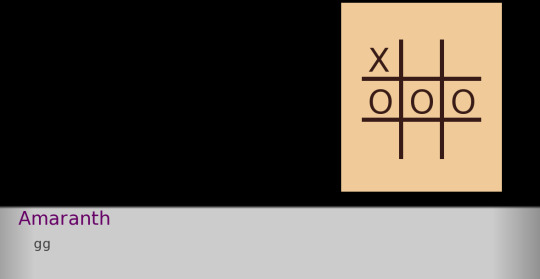
That concluded my day-work!
Night I.
So I decided to push forward and actually coded in her responses!
I took and hardcoded the first two turns for her Xs and the rest was assigned at random. As for Os, I made it do everything at random, since she’s more experienced at playing Xs! (totally not because I didn’t want to look at tic-tac-toe ever again)
Each turn the machine checks if there are any free spaces and if any of the rows match winning conditions. If they do, the player gets to the end plot (I still haven’t written any of it, aaaa!). If they don’t, the game continues until it’s a draw or X’s/O’s win.
With that, I finally slumped into the bed. Even with taking breaks it was kind of a hard exercise to be jumping straight into after a. Year. Of not working with Python’s syntax.
[I’ve cut off a huge text segment of me trying to design a less clunky random placement system, but all of my endeavours led to dead ends caused by my inexperience and complex requests. Thank you for all the answers, StackOverflow! So many people asking the same question, it makes me feel like we’re all a part of a big community…]
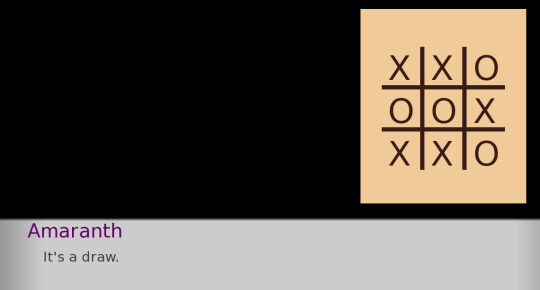
#nitunio.txt#nitudev#< lord knows i wont be using this tag much after the jam#o2a2#o2a2 vn jam#game jam#renpy
3 notes
·
View notes